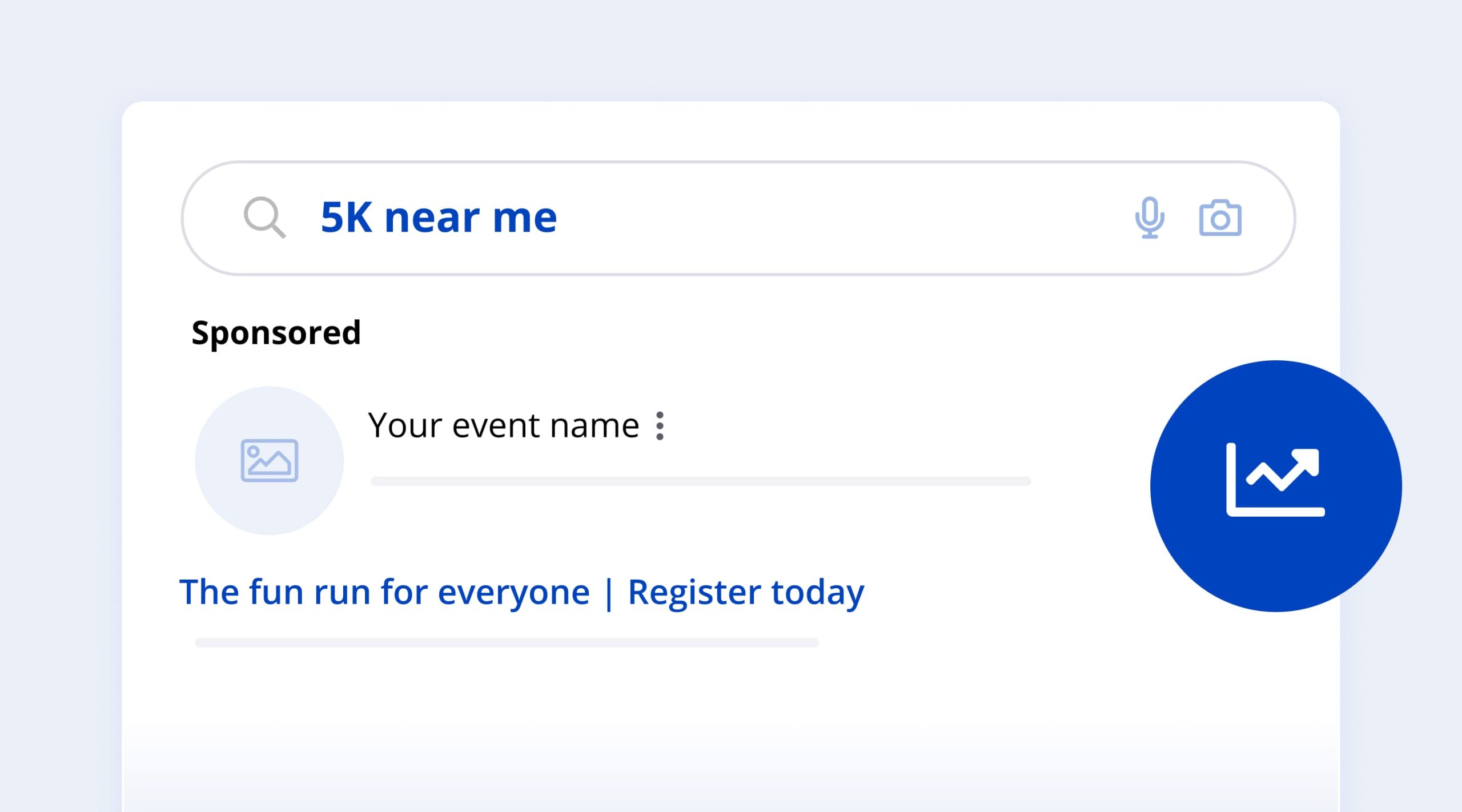TIPS & TRICKS | Estimated Read time – 6:50

An effective digital marketing strategy will take your endurance event to new heights.
You can create buzz across multiple digital platforms by targeting specific groups of people who are interested in your event to make sure your message gets to the right audience.
What is digital marketing? It’s a range of online tactics and strategies to reach and engage target audiences, drive traffic, generate leads, and ultimately convert prospects into customers.
Digital marketing uses tools like social media, search engines, email, and more to help you reach your potential participants where they spend a lot of their time — online.
5 Peaks Trail Running Series – Digital marketing

“Like most event organizations, our primary goal is to create meaningful, memorable experiences for as many people as possible. We use a variety of approaches to promote & share information about our events from targeted emails, brand ambassadors, social media, maintaining and housing all of the pertinent event information on our website which leads potential participants to register for our events through Race Roster.”
– Jacob Puzey
5 PEAKS TRAIL RUNNING SERIES
While it can feel overwhelming, digital marketing shouldn’t be complicated. There are simple steps you can take to integrate an effective digital marketing strategy into your day-to-day schedule.
Let’s explore three digital marketing tactics that can be easy for you to implement, easy for you to maintain, and will get you real results.
1. Boost your social media posts

Social media is one of the easiest ways to engage with your target audience. Boosting your best social media posts is a simple and cost-effective way to take that engagement to the next level.
The biggest roadblock that event organizers like you face on social media is that most platforms are now pay-to-play, meaning you have to spend money to have an impactful reach.
You can reach your target audience organically, but you’ll never get the most out of social media without a financial investment. Unfortunately, only about 35% of your organic followers will see any particular post on your Facebook and Instagram without a boost – which means you are not even reaching the audience who wants to hear from you without a paid campaign.
The good news is that you don’t need to blow your budget on boosted social media posts to get more reach.
You can easily reach a larger portion of your target audience by spending just $10 or $20 to boost a post on Facebook or Instagram. You’ll also grow awareness of your event by reaching all the audiences who already follow you, plus more people you wouldn’t reach otherwise.
When you boost posts, your social media channels can go from little-to-no engagement and interactions to hundreds of likes and thousands of impressions. Here’s how you can boost posts, optimize boosted posts and measure the success of your boosted posts. You can also learn about other social media marketing strategies to increase your event’s registration.

Pro tip
Measure the effectiveness of your advertising efforts with the Facebook tracking pixel and see the actions people take on your registration page when they access it through Facebook.
2. Run a paid Google Search campaign

Creating a paid Google search campaign can help your event stand out from the overwhelming number of results on every search engine results page (or SERP).
When potential participants search for specific keywords related to your event, your ad can appear prominently on the SERP.
Here’s how a paid Google search campaign works:
1. You choose the relevant keywords for your event or location that you want your ad to show up for — like “5K near me” or “5K in my city”.
Tip: You can choose as many keywords as you’d like, but we recommend 10 to 15.
2. You create text ads geared toward your target audience to catch their attention and encourage them to click through to your website and register for your event.
Tip: Make your ad’s headlines engaging and impactful to capture attention and drive clicks. Improve the click-through rate of your ad by mentioning the event is selling out fast, a deadline before a price increase or a unique value proposition.
3. You bid on how much you’re willing to pay each time someone clicks on your ad (this is called pay-per-click, or PPC), and Google decides which ads show up and in what order.
Paid Google search campaigns are powerful digital marketing tools because they allow you to reach high-intent customers right at the moment they are searching for a race.
Plus, you can track how many clicks and sign-ups you get from your ads, so you can evaluate the performance of your campaign in real-time and tweak it to improve results.

Pro tip
Utilize Race Roster’s Google Analytics 4 functionality to track the page views, transactions and revenue generated directly by your Google search campaign..
What does success for your Google search campaign look like? One of the key performance indicators for search campaigns is Return on Advertising Spend (or ROAS). This metric measures the revenue your campaign earns for each dollar you spend.
However, it’s important to remember that your Google search campaign may not immediately increase your revenue directly. Often, a paid search campaign will boost awareness of your event, leading to a purchase down the road.

For example, a potential participant searches for a 5K in their city and your Google search ad pops up. This is the first they’ve heard of your event, so they don’t register immediately. Instead, they research, talk with their partner, and eventually sign up for your event.
In this instance, your search ad didn’t result in a direct conversion, but still played a vital role in a new registration. Keep this customer journey in mind as you analyze the performance of your Google search campaign.
Events that are registered non-profits or organized by a non-profit can apply for a Google Ad Grant. A Google Ad Grant provides qualifying non-profit organizations with up to $10,000 monthly in search ads.
If you don’t have to spend money on your search ad, your Return on Advertising Spend is any money it generates. That’s a big win for you and your event.
3. Embrace the impact of email

Never underestimate the power of email. It’s the most impactful digital marketing tactic by far and is highly effective at maintaining registrant retention rates.
Thanks to tools like personalization and audience segmentation, you can tailor your email content exclusively for your audience in ways that will resonate.
The best event email marketing uses these tools to build meaningful relationships with participants and deliver customized content beyond registration announcements, details about event-day logistics, and thank-you messages.
By sending your email subscribers useful, engaging content and keeping them constantly informed about your event, you can turn casual participants into loyal fans who keep returning (with their friends and family) year after year.
Like with social media, the most effective event email marketing is year-round. Here are five email content ideas you can use to keep your participants engaged, even in the off-season:
· Training Tips and Advice: Share tips that help your participants stay motivated to move year-round. This could include running techniques, nutrition tips, or workouts.
· Exclusive Offers and Discounts: Reward your participants with exclusive registration discounts, special offers on swag, or perks for being a member of your email list.
· Community Events: Promote local businesses, charity partners, or running groups to help foster a sense of community among your participants.
· Behind-the-Scenes Content: Highlight the individual volunteers, sponsors, and staff members that help bring your event to life.
· Participant Spotlights: Tell the inspirational stories of participants within your community, sharing their accomplishments and reasons for being part of your event.

Pro tip
Use Race Roster tracking links to access valuable email statistics like clicks, conversions, and monetary value. You can use these stats to measure email performance and adjust your strategy.
5 Peaks Trail Running Series – Email marketing

“We have a robust newsletter list, but also use pre and post race emails to direct participants back to our website. Rather than posting all of the event info in the pre race emails, we direct participants to our website for the race day schedule, course maps, descriptions, etc. We house links to our results on our website and send out a link to results as well as race day photos via Race Roster’s email campaign feature.”
– Jacob Puzey
5 PEAKS TRAIL RUNNING SERIES
Conclusion

Digital marketing shouldn’t be overwhelming. It’s a simple yet impactful way to separate yourself from the pack and grow your event.
When you know effective tactics for your event and audience, you can harness powerful tools like social media, Google search campaigns and email marketing without wasting your time or money.
Successful digital marketing is all about planning and adapting. So, create a well-thought-out plan of attack, be patient as you put that plan into place, and then be ready and willing to adjust that plan when necessary to improve performance.
Before long, you’ll notice the impact a digital marketing strategy can have on the success of your endurance event.

What’s new at Race Roster?
Visit our what’s new page for the most noteworthy Race Roster updates!